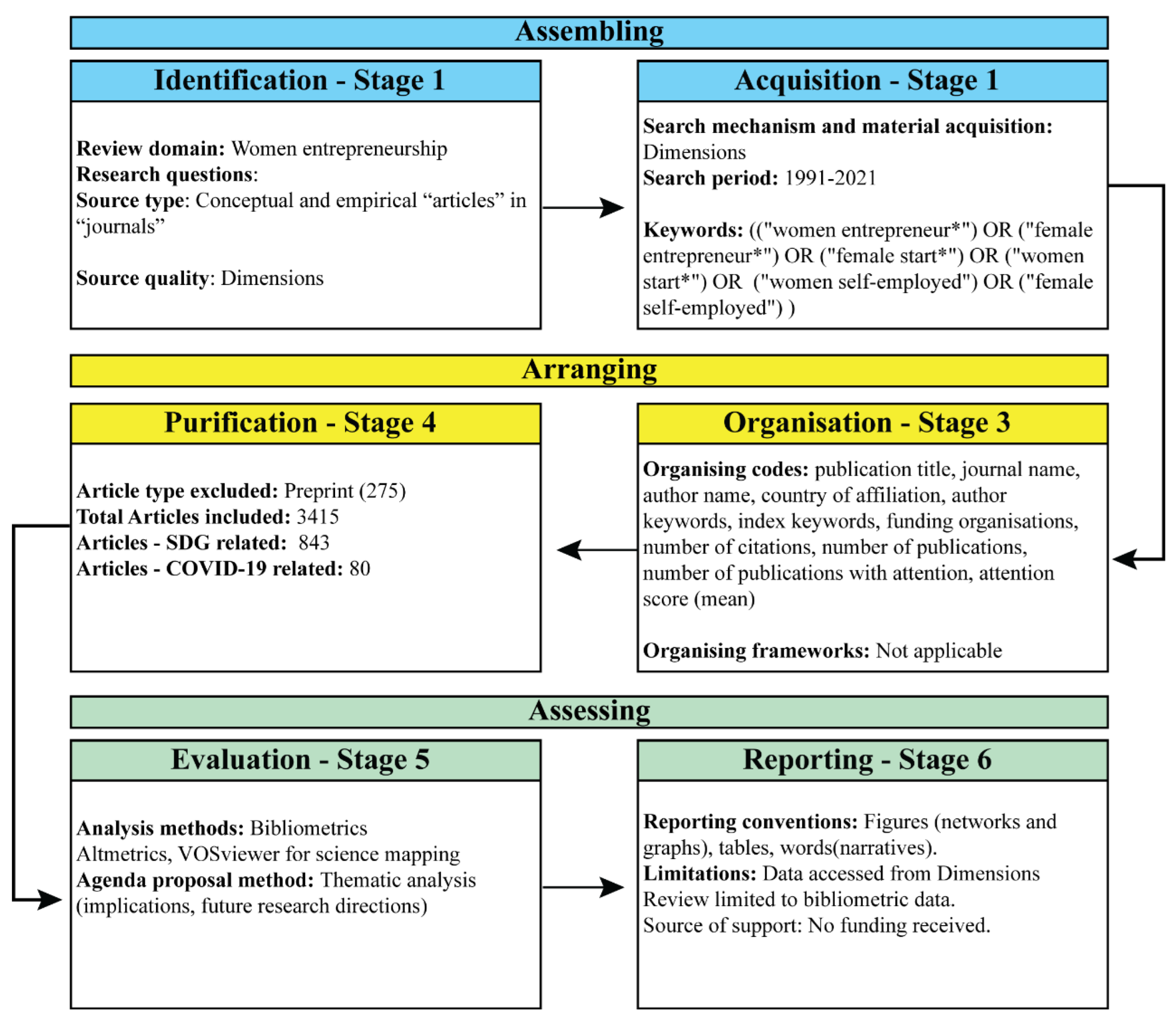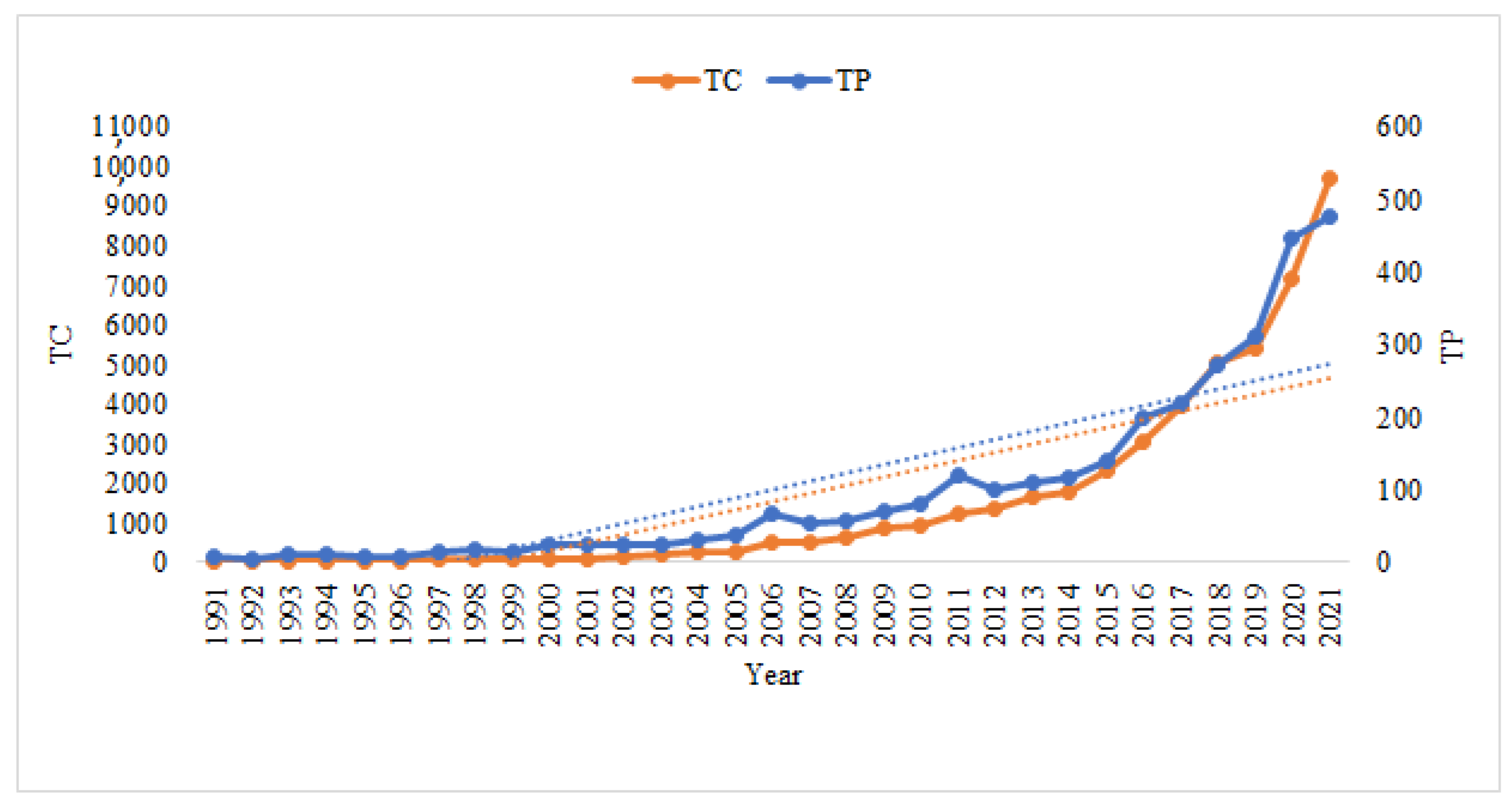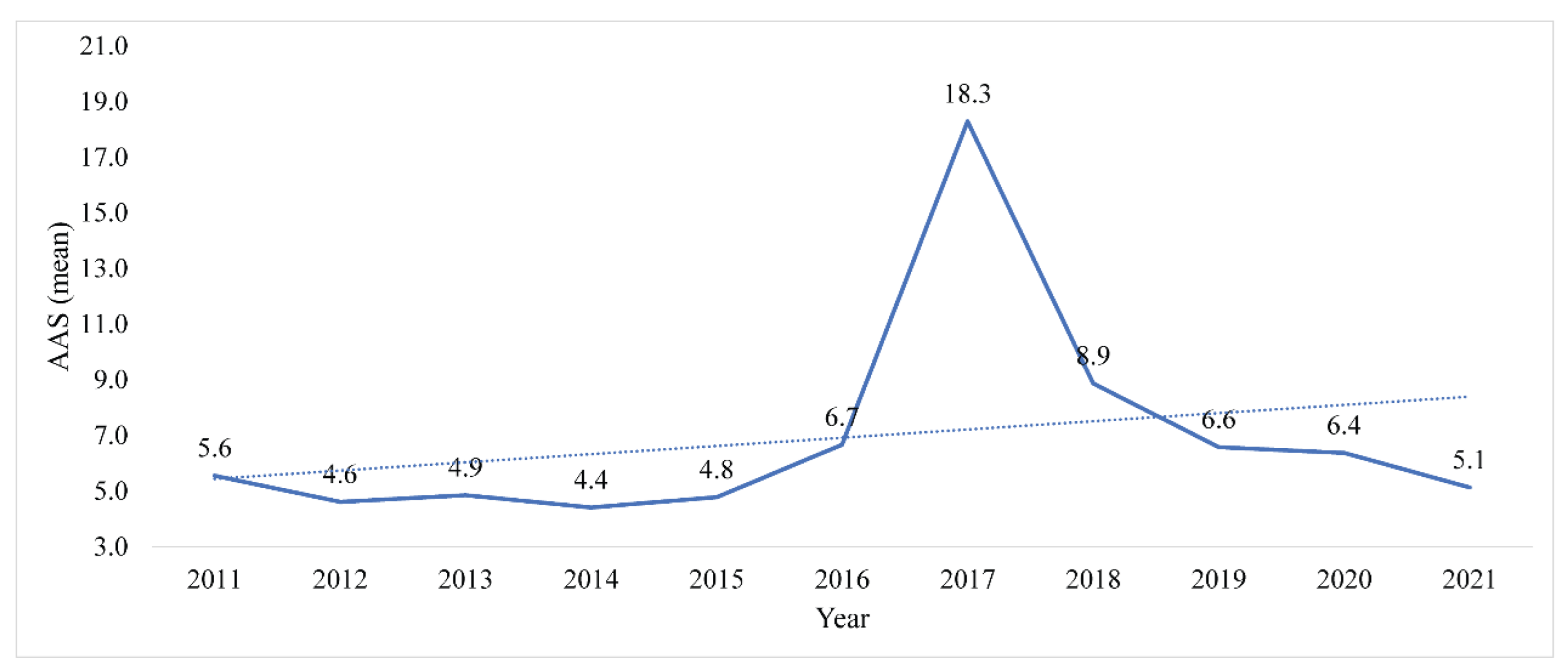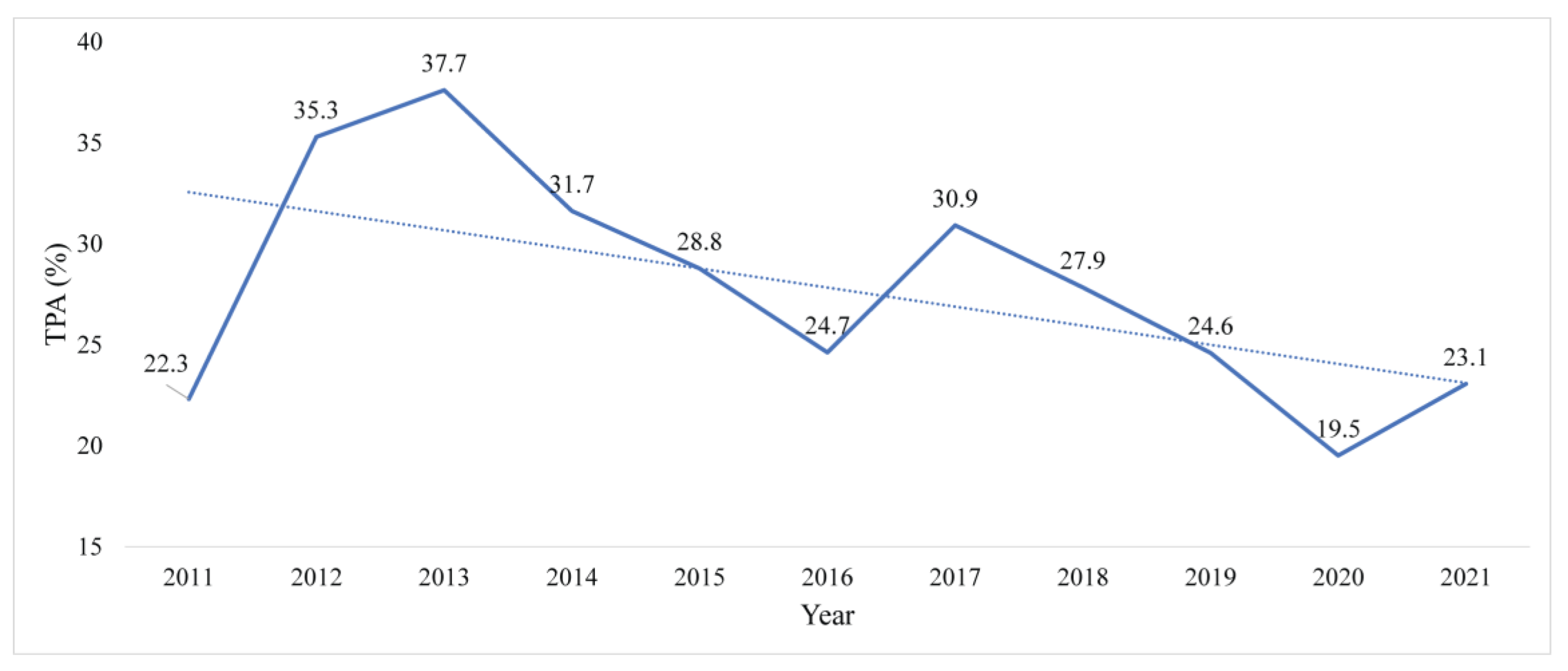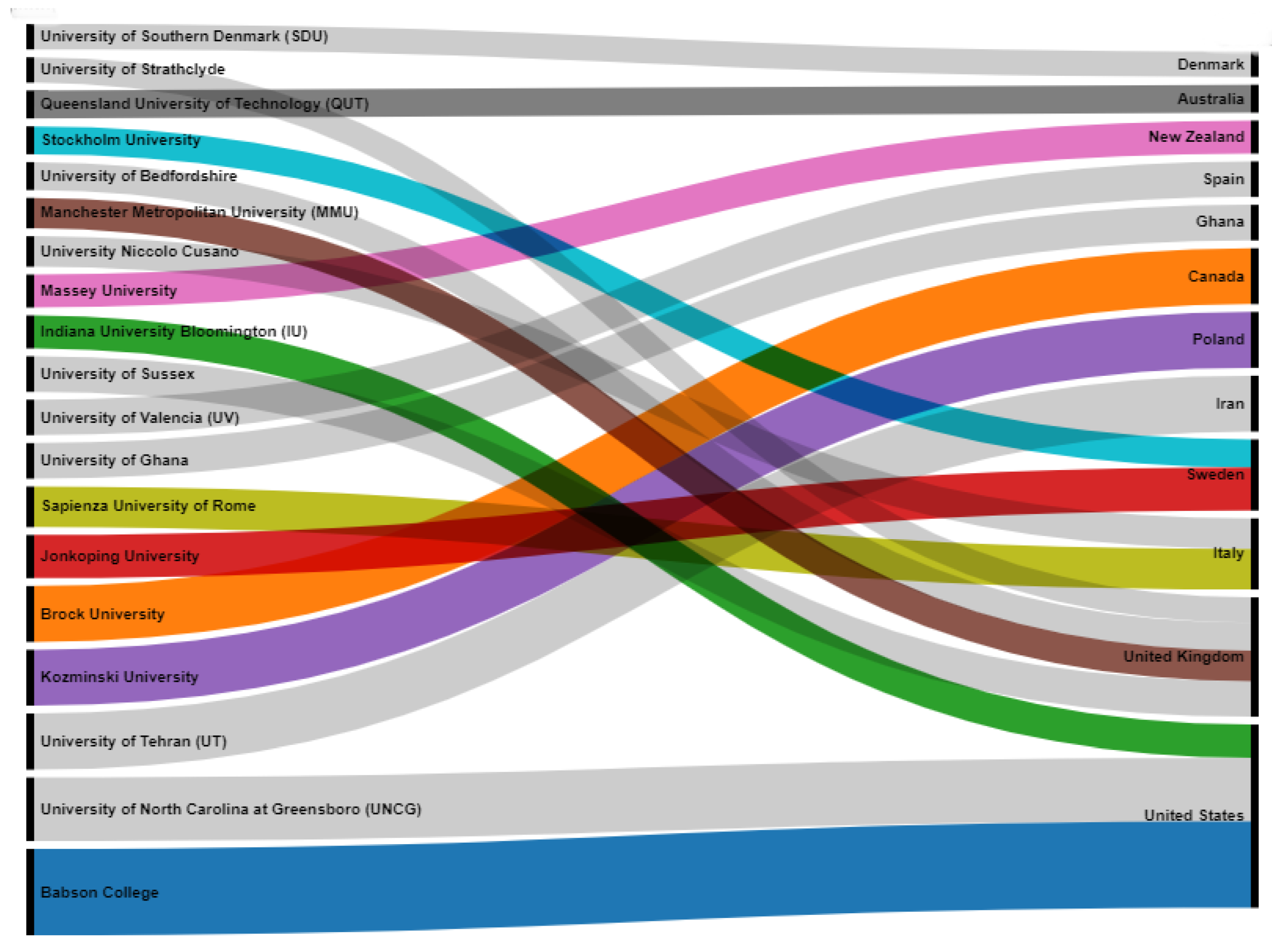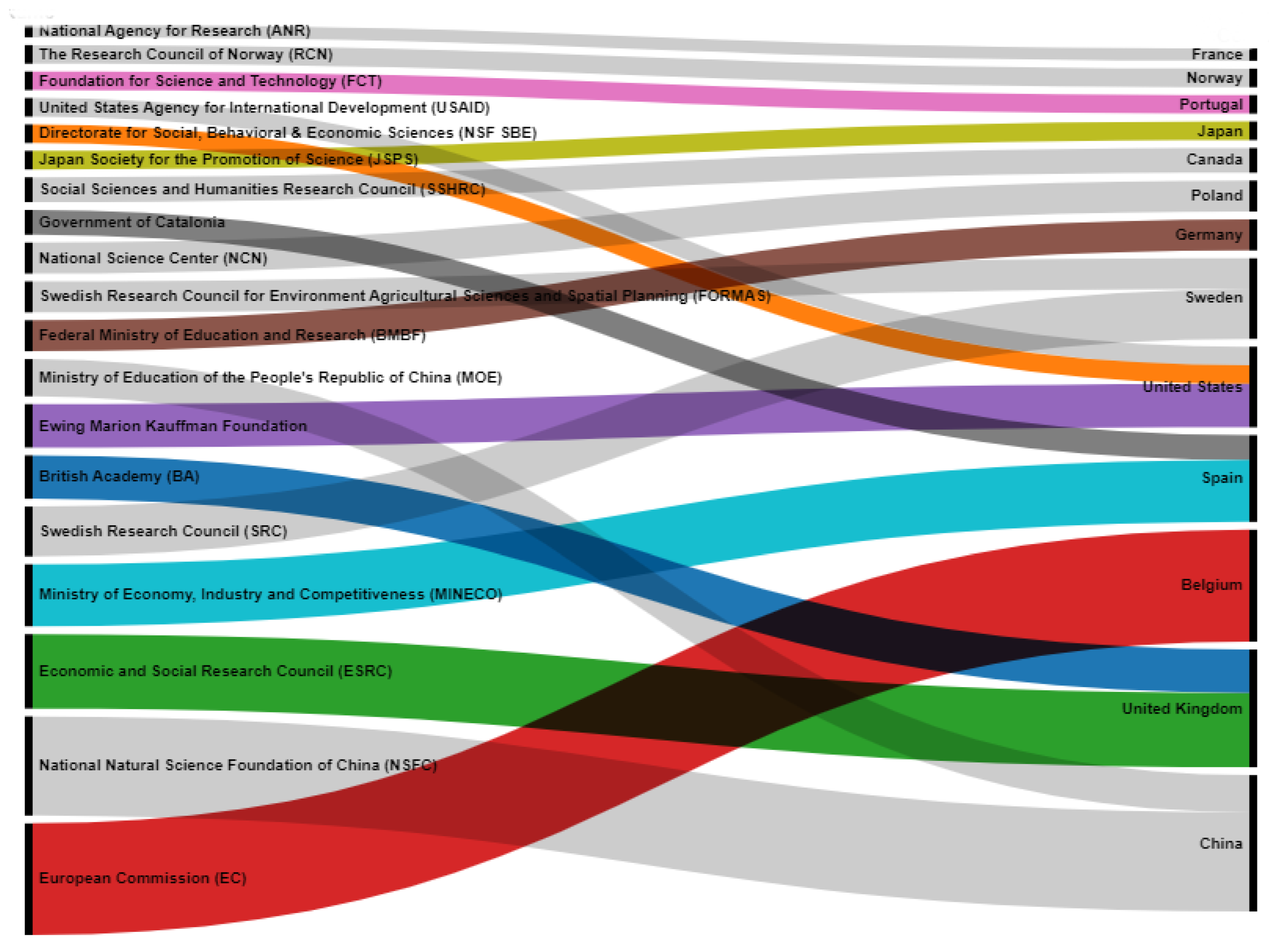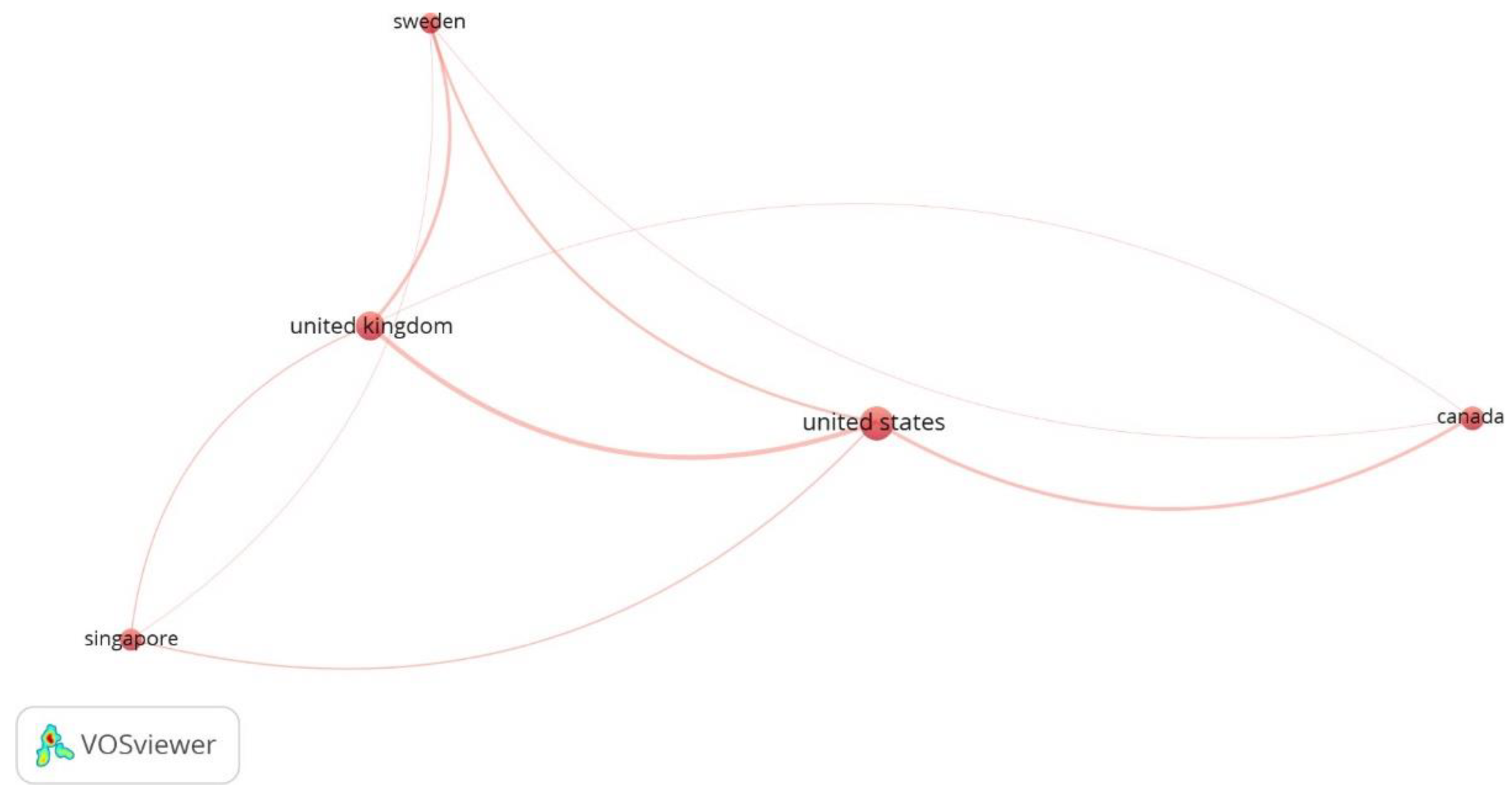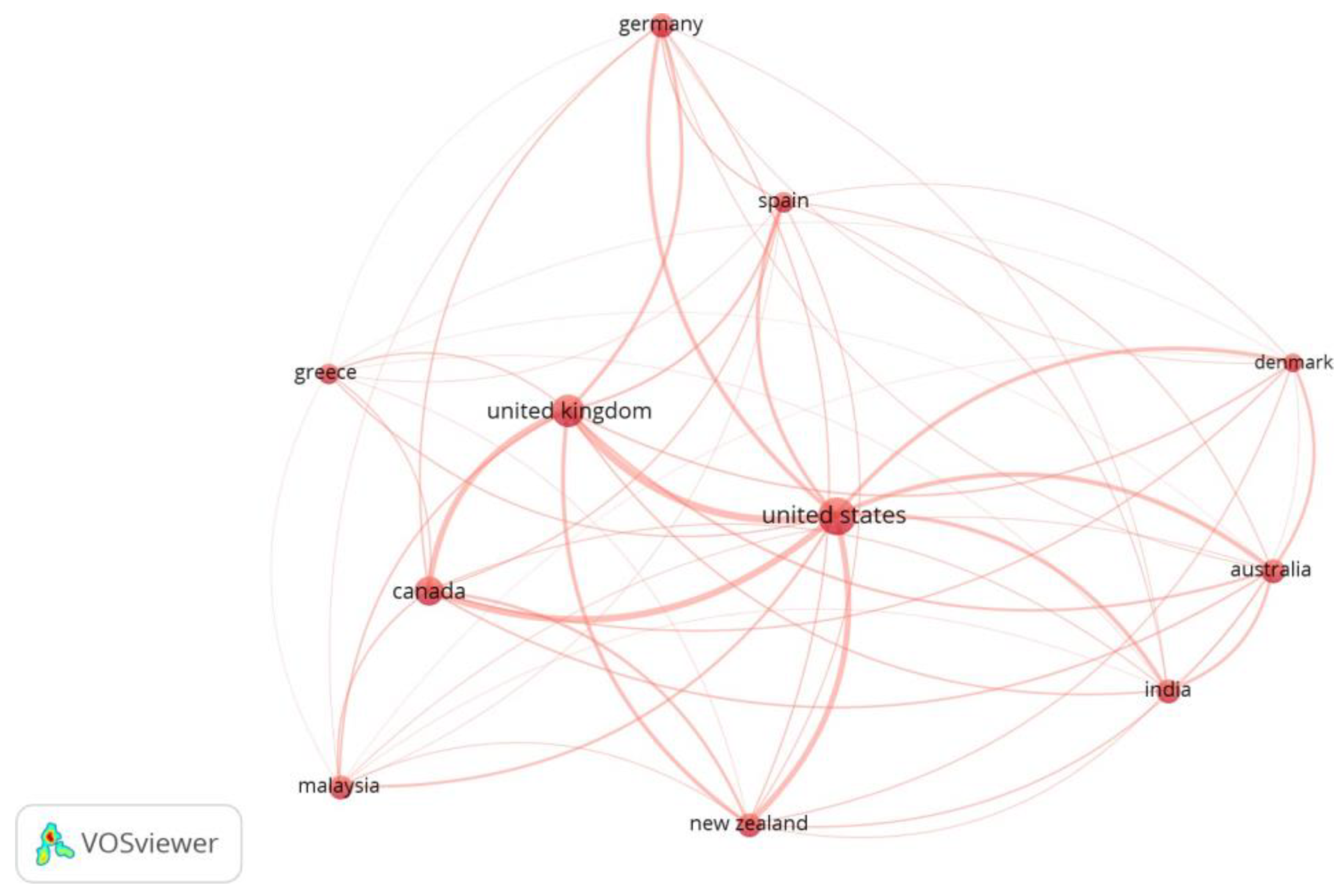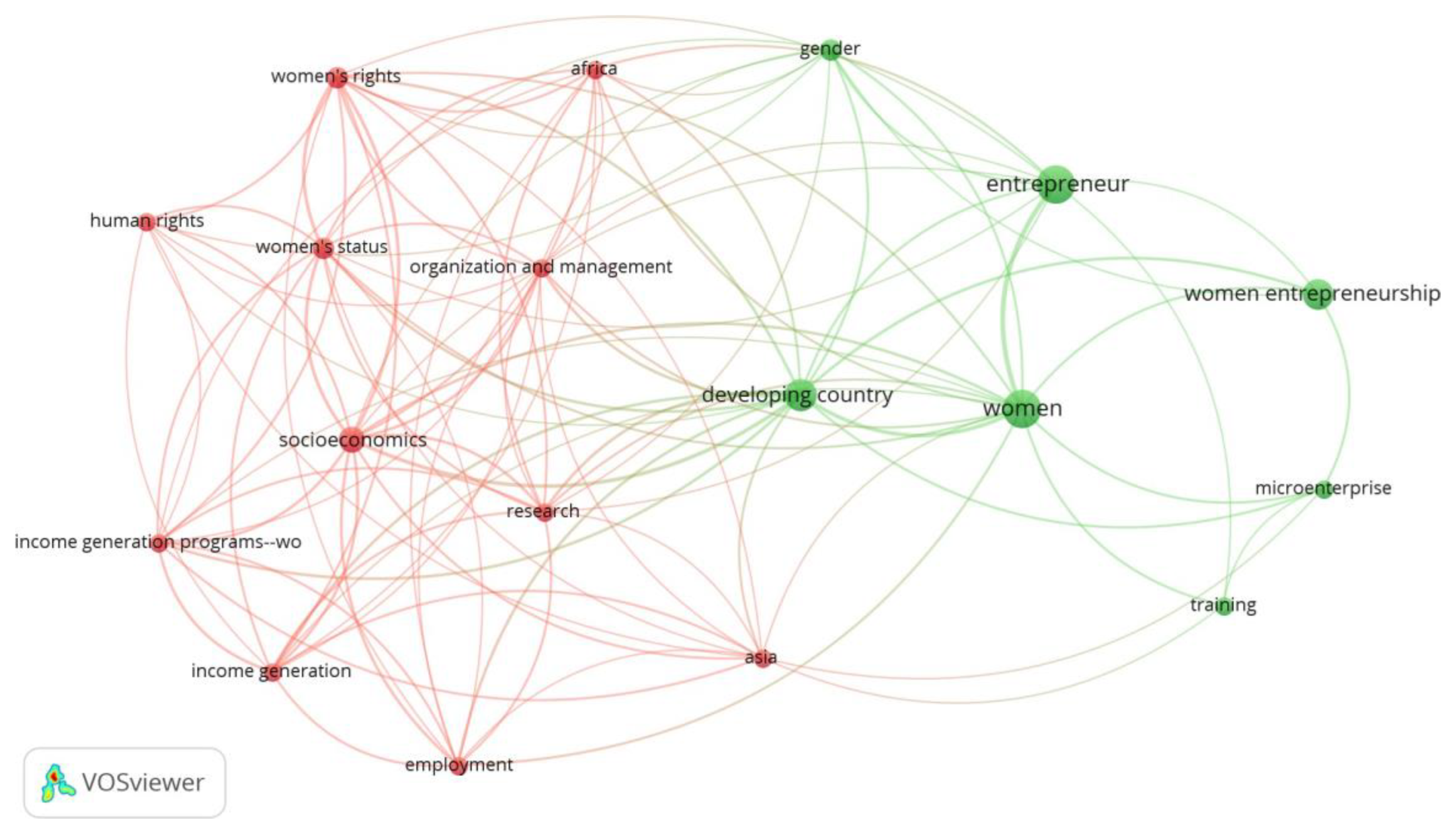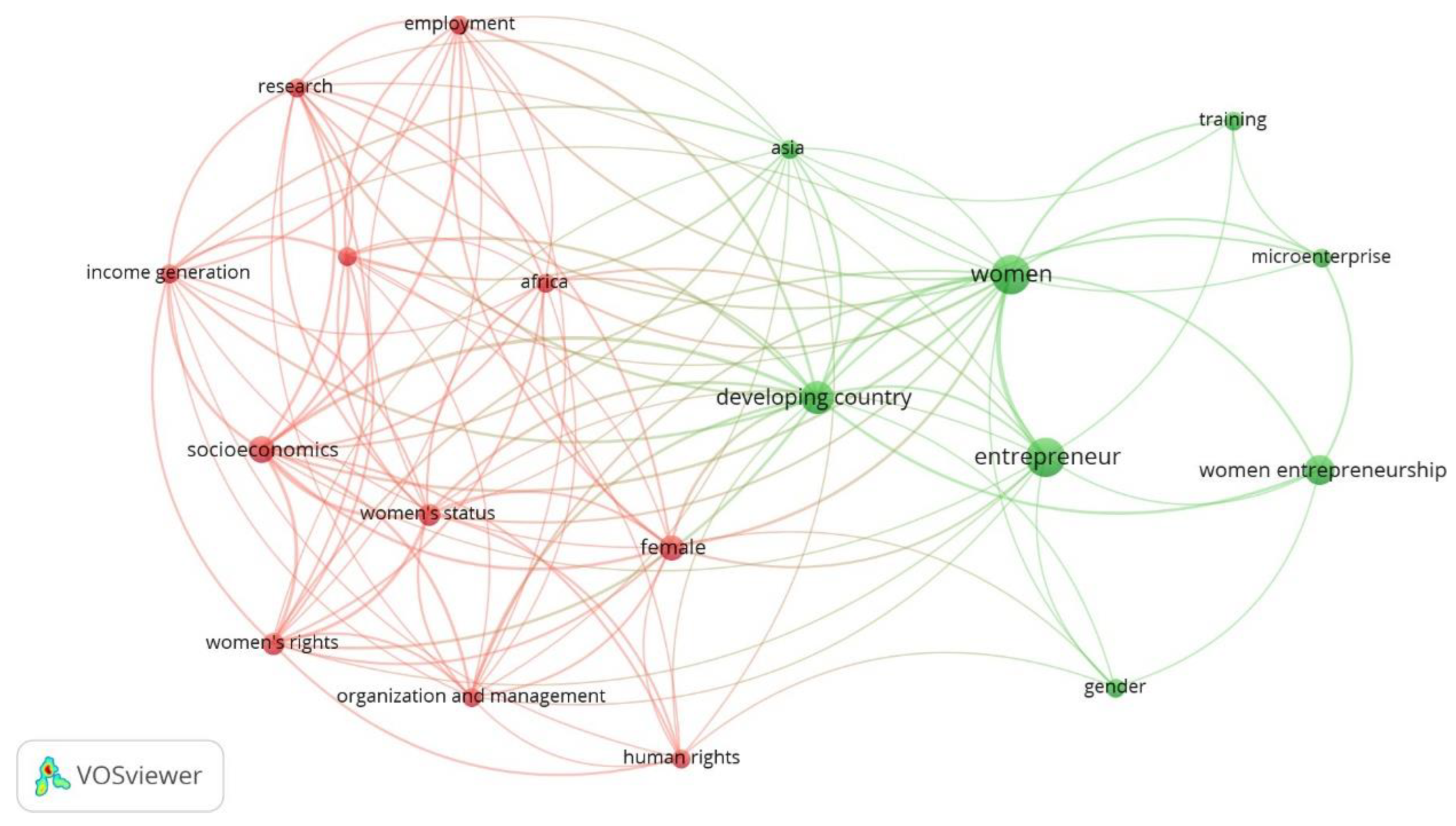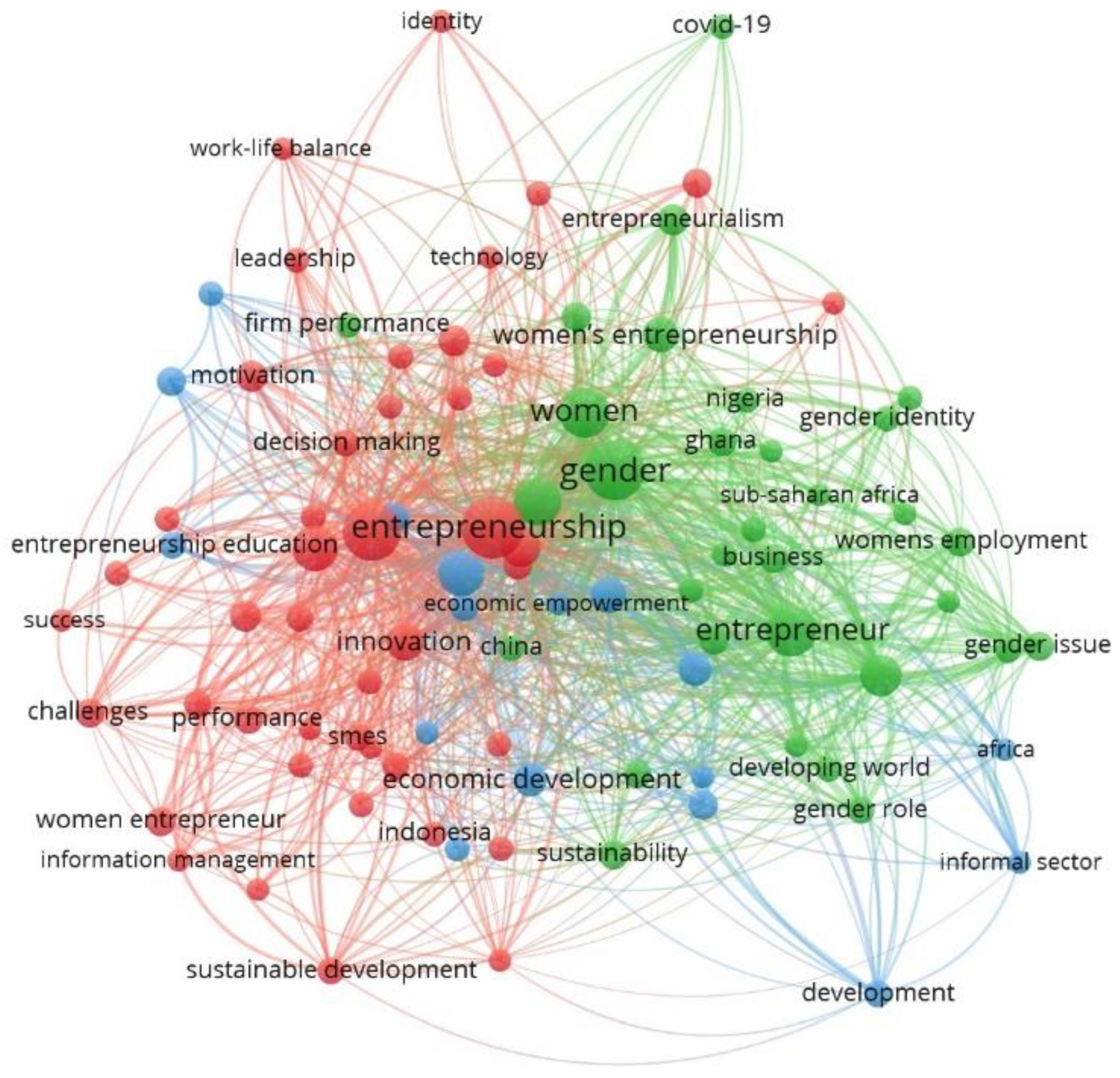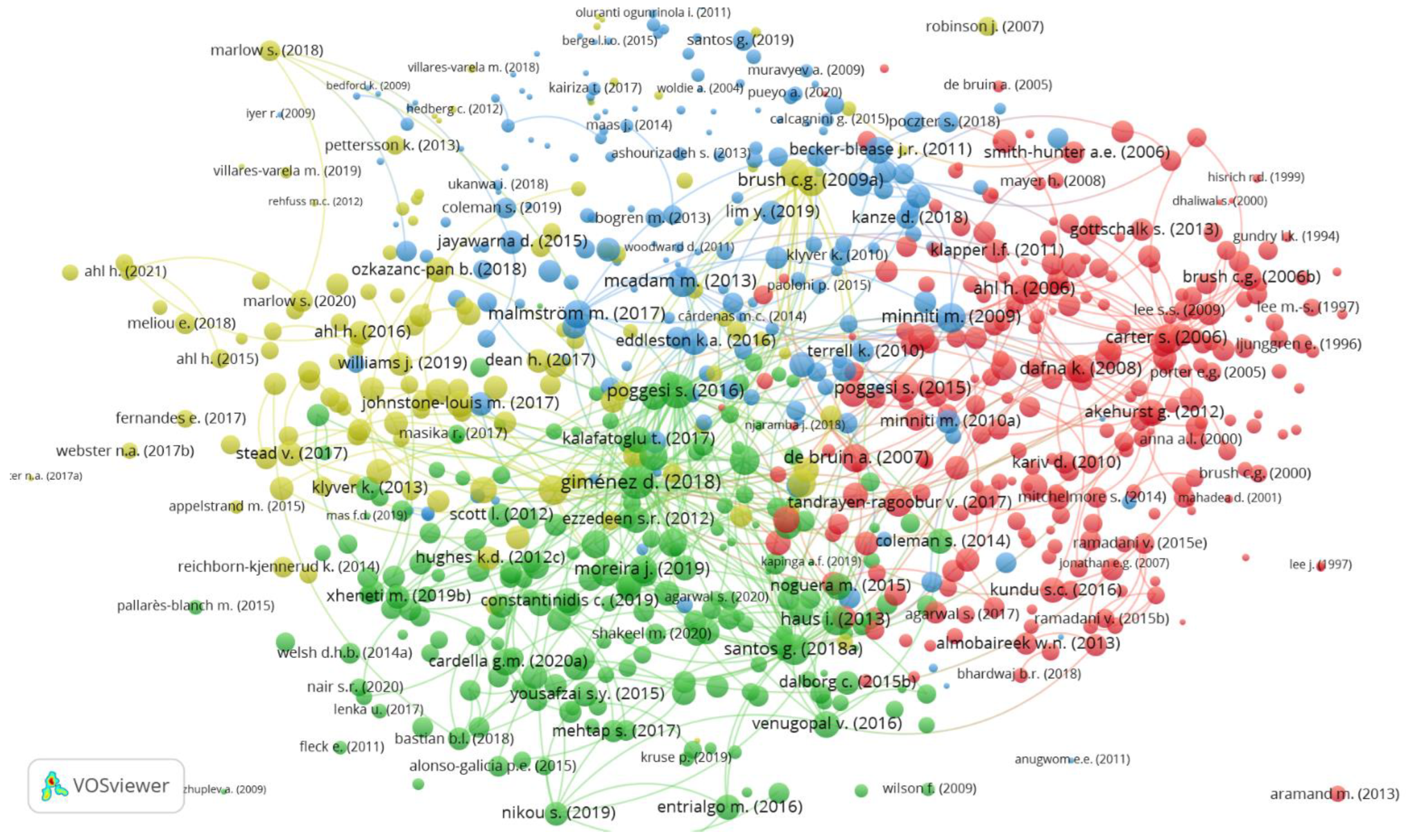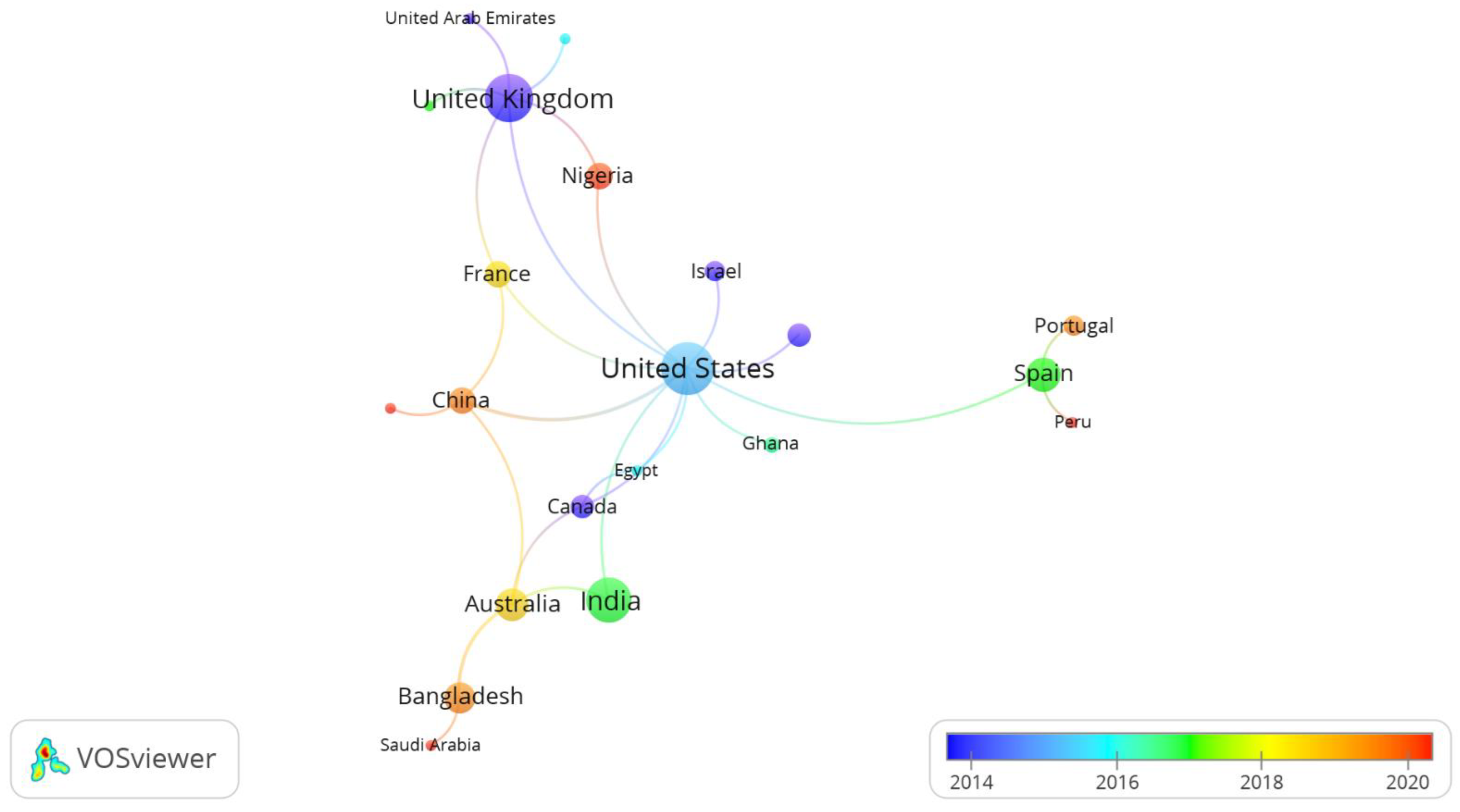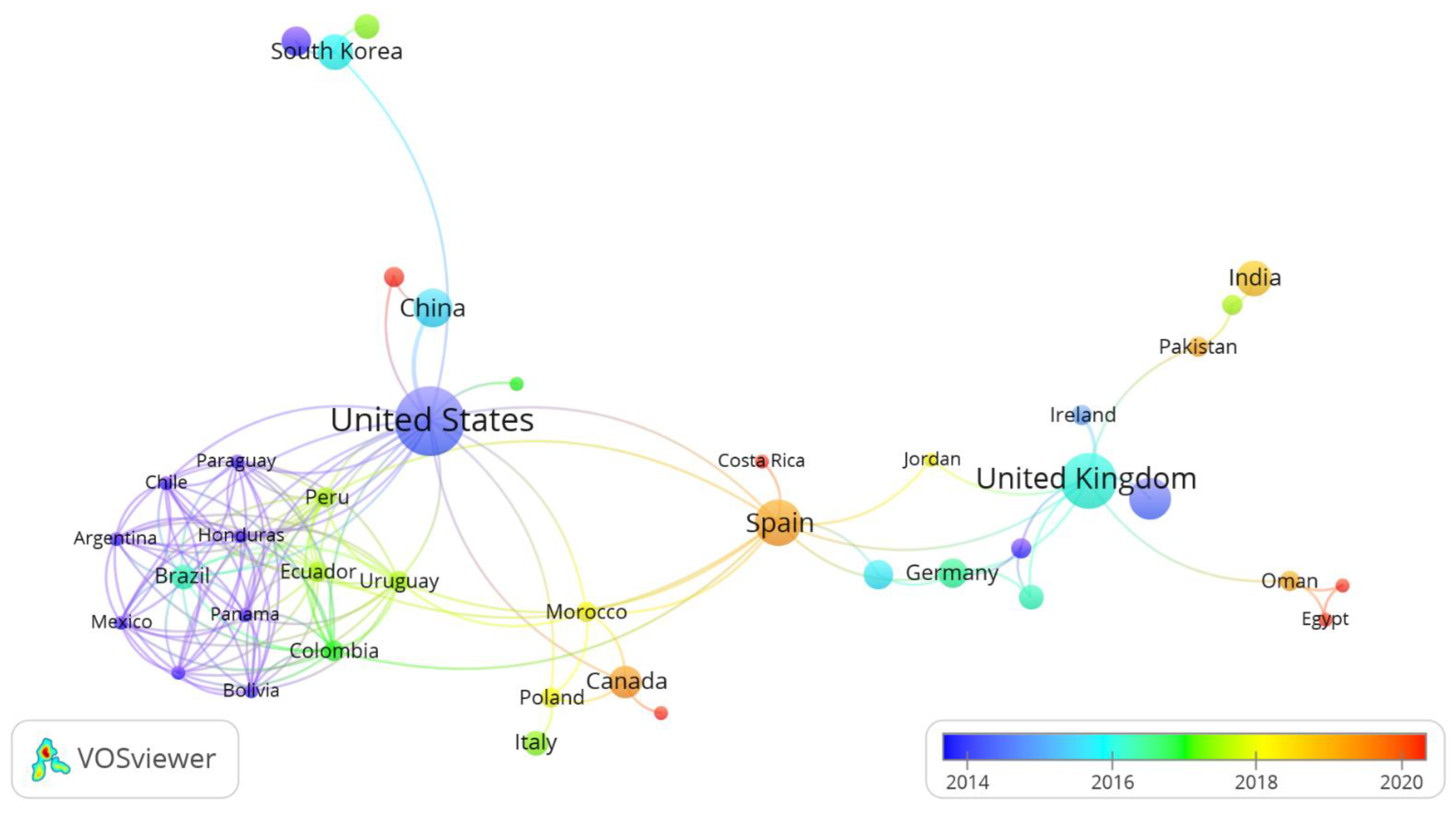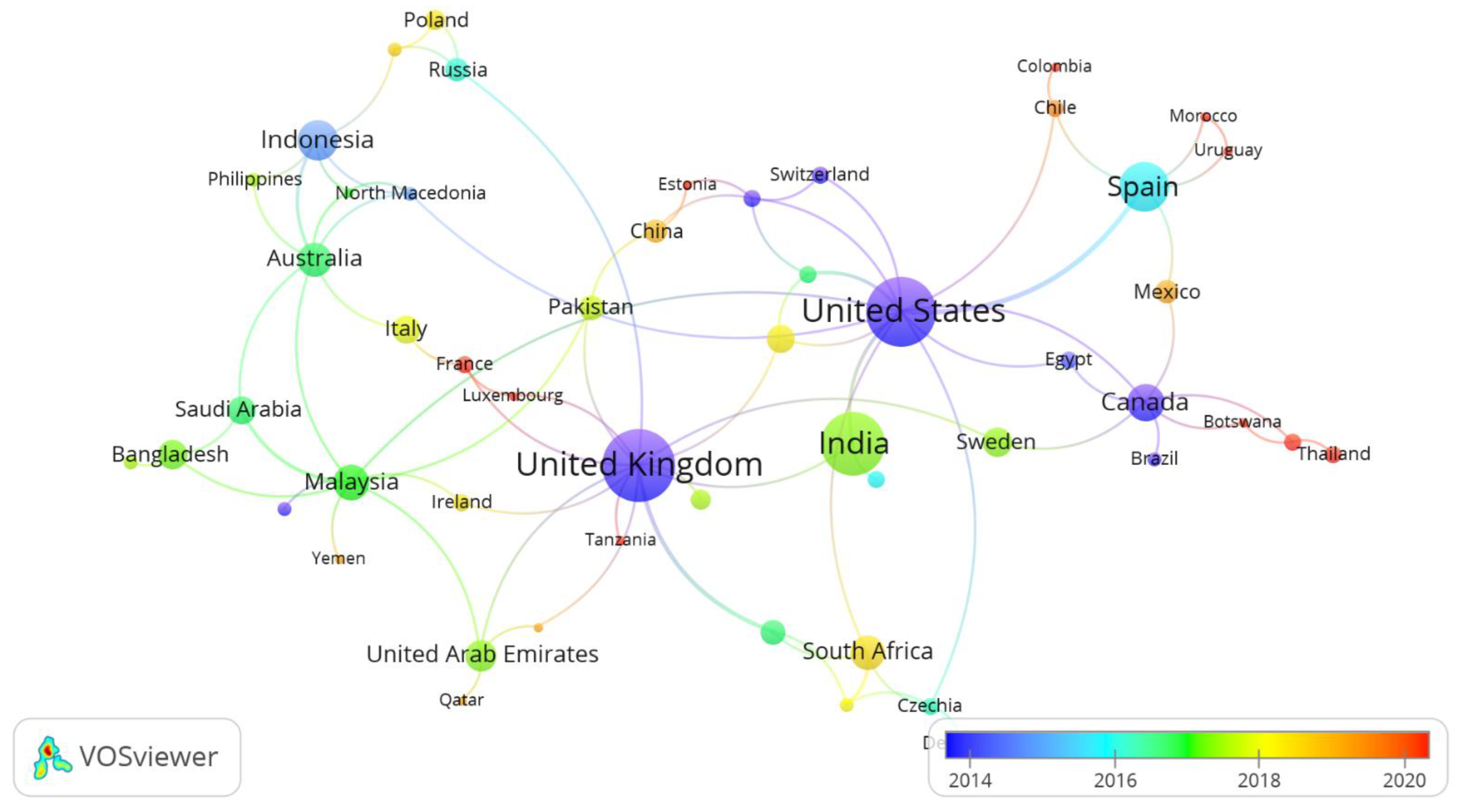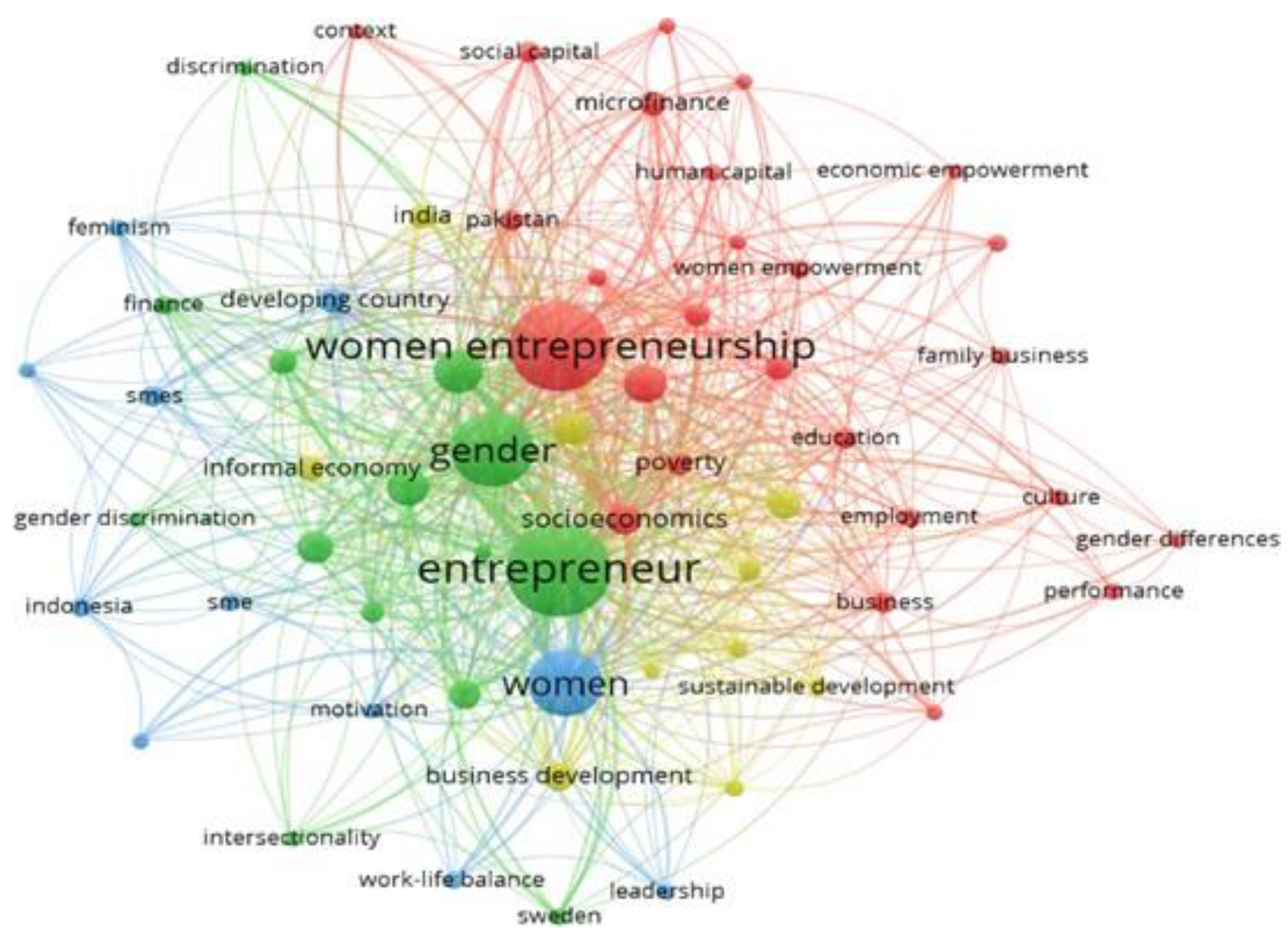5.8. Bibliographic Coupling Based on Countries
Bibliographic coupling and co-citation analysis are the most widely used citation-based techniques [
59]. They are more appropriate for studying emergent literature fields and capturing current research trends within an area than other methods [
60,
61]. Kessler (1963) introduced bibliographic coupling as one of the most common citation-based coupling measures of similarity between scientific items. Bibliographic coupling can be used to explore the similarities in different research actors such as journals, institutes, and countries. It refers to the number of shared references between two articles [
45].
Bibliographic coupling has been used to understand trends in publications and citations in three time periods: T1 (1991–2000), T2 (2001–2010), and T3 (2011–2021). There is only one cluster (red) in T1, with five countries with TP: 52, TC: 126, and TC/TP:2.42 (
Figure 8). The United States has the most publications and citations (TP: 17, TC: 854) in this cluster. In T1, the foci of the most highly cited (TC) publications are gender, work, family variables, the prospects of men’s and women’s businesses, and the performance analysis of male and female entrepreneurs.
In T2, we can see 1 cluster (red) in T1, but the number of countries has increased from 5 to 11 (
Figure 9), with TP: 331, TC: 1719, and TC/TP: 5.19. In T2, the most publications and citations are from the United States (TP: 50, TC: 1520), followed by the United Kingdom (TP: 29, TC: 520). Research contributions from countries such as Australia (TP: 11), India (TP: 11), and Germany (TP:10) started featuring bibliographic coupling from T2. The research themes in T2 mainly focused on gender framework and stereotypes, research frameworks for women entrepreneurship, and the growth and venture size of women entrepreneurs.
We can see an exponential increase in the research output on women’s entrepreneur- ship in T3, and
Figure 10 demonstrates the same. Three clusters (red, green, and blue) can be seen: cluster 1 (red) with 24 countries (TP: 962, TC: 6597), cluster 2 (green) with 16 countries (TP: 912, TC: 10,079), and cluster 3 (blue) with 15 countries (TP: 715, TC: 8482). The country with the most scientific interest in the women entrepreneurship theme in cluster 1 is India (TP: 235, TC: 908); in cluster 2, it is the United States (TP: 467, TC: 6851), and in cluster 3, it is the United Kingdom (TP: 279, TC: 4834). Though the publications (TP) from India are the highest in number, the citations (TC) are more from publications from the United States, which may be because of the early contributions from the researchers. The foci of the researchers in T3 are new directions and dimensions of research in women entrepreneurship, women empowerment, challenging myths in women entrepreneurship and institutions, and women entrepreneurship, which highlights the acceptance of women in entrepreneurship, breaking gender stereotypes, and the role that gender stereotypes play in society.
5.9. Keyword Co-Occurrence Analysis
The co-occurrence network analysis [
62,
63] investigated female entrepreneurship themes’ hot topics and research frontiers. VOSviewer was used for the co-occurrence analysis of keywords in three time periods, i.e., T1 (1991–2000), T2 (2001–2010), and T3 (2011–2021), to provide easy-to-interpret clusters of hot topics in women entrepreneurship literature [
44]. A coherent narrative has been created by arranging each cluster’s keywords [
52]. Keyword co-occurrence analysis shows cluster 1 (red: 12) and cluster 2 (green: 7) during T1 (
Figure 11). A threshold of 5 was kept, and it returned a total of 26 keywords. The main keywords in cluster 1 are Africa, employment, human rights, research, socioeconomics, women’s rights, income generation, women’s status, organization, and management, which can be grouped under the theme “women’s rights and socioeconomic status.” Cluster 2 includes women entrepreneurship, microenterprise, developing country, and gender, grouped under “micro-enterprise and gender.”
In T2 (
Figure 12), we can see two clusters, with keywords in both cluster 1 (red: 10) and cluster 2 (green: 8). A threshold of 5 was kept, and it returned a total of 24 keywords. The main keywords in cluster 1 are Africa, employment, female, human rights, research, socioeconomics, women’s rights, income generation, women’s status, organization, and management, grouped under the theme “women’s rights and entrepreneurship”. Cluster 2 includes Asia, developing country, women, entrepreneur, training, microenterprise, and women entrepreneurship, within the theme “microenterprise and women entrepreneurship.” In T2, the research was focused on women entrepreneurship models and gender equality.
In T3, three clusters (red, green, and blue) are visible (
Figure 13). We can see 44 keywords in cluster 1 (red), 32 keywords in cluster 2 (green), and 17 keywords in cluster 3 (blue). A threshold of 5 was kept, and it returned a total of 93 keywords. Cluster 1 has major keywords such as barriers, business, performance, challenges, commerce, decision-making, and sustainable development, grouped under the theme of “barriers and enablers to women entrepreneurship.” Cluster 2 has keywords such as business, business development, China, COVID-19, economic growth, and developing world, which focuses on “gender and woman entrepreneurship.” Cluster 3 has keywords such as economic development, employment, self-efficacy, and social entrepreneurship, highlighting “economic development and women entrepreneurship.”
A review of keyword co-occurrence across the three time periods (i.e., over the three decades) indicates economic development, employment, and gender roles and rights to be constant issues of interest for research. However, in T3, there were many more keywords, publications, and a more complex web on interlinked ideas and themes. Sustainable development as a keyword was linked to information management, SMEs, technology, women entrepreneur, and entrepreneurship education, flagging education issues and building awareness on entrepreneurship being critical.
5.10. Bibliographic Coupling of Publications
An analysis of the bibliographic coupling network based on publications is shown in
Figure 14, which allows for the establishment of clusters of publications that are semantically and thematically closest to each other [
44]. The relatedness of the publications is determined based on the number of references they share. The size of the circles is proportional to the number of citations. The lines connect publications co-citing another publication. The total link strength reflects the number of references co-cited by the two publications.
To identify the strongest relations, a threshold of 10 citations per publication was kept, which returned 809 out of the total of 3157 publications, resulting in four clusters. Cluster 1, shown in red, has 263 publications, cluster 2 in green has 210 publications, cluster 3 in blue has 193 publications, and cluster 4 in yellow has 143 publications.
Table 7 shows the top ten documents based on total link strength. The publications with the highest link strength were by Giménez D. (2018), Poggesi S. (2016), Santos G. (2018a), Carter S. (2006), and Mcadam M. (2013), and most of the documents are from cluster 2.
The four clusters in
Figure 14 are further analyzed for thematic areas. The top three publications in each cluster based on the total link strength are shown in
Table 8. The main theme of cluster 1, highlighted in red, is “women entrepreneurship research”, cluster 2 (green) is “gender effects and entrepreneurship”, cluster 3 (blue) is “gender issues in entrepreneurship”, and cluster 4 (yellow) is “gendered perspective of entrepreneurship”.
5.11. Women Entrepreneurship and SDG
Dimensions automatically assigns an SDG category to publications [
64]. We found 843 publications based on women entrepreneurship and SDG from the total sample of 3157 publications and selected SDG 10, SDG 8, and SDG 5, which accounted for 90% of publications. We also looked at the Sustainable Development Report [
65] to understand where each country stands on achieving the 17 SDG. We used the overlay feature of the VOS viewer to show SDG publication trends over time.
In SDG 10 (
Table 9), there are three clusters with 21 countries, and the United States, which is ranked 32 in the SDG rank index, is the highest contributor to the women entrepreneurship theme (TP: 21, TC: 617). Spain, ranked 20th in the SDG rankings, is second with TP: 9 and TC: 28, followed by Canada (SDG rank: 21), with TP: 4 and TC: 20. SDG 8 has three clusters with 41 countries, whereas SDG 5 has four sets with 52 countries. The United Kingdom (SDG rank: 17) features as the highest contributor in SDG 8 (TP: 14, TC: 406), and Indonesia (SDG rank: 97) is the highest contributor in SDG 5 (TP: 15, TC: 318). Although Sweden ranks second in the SDG rank index and is featured third as per the table, the full publications (TP) are only eight, with total citations (TC) of 166.
The network overlay visualization shows the countries contributing to the research area of women entrepreneurship literature by the year of publication. According to overlay visualization, yellow frames represent recently published countries. The network overlay (
Figure 15) shows that the work on women entrepreneurship and SDG 10 (reduced inequalities) was already prevalent from the UK, Israel, and Canada in 2014. Researchers from countries such as Bangladesh, Nigeria, Peru, and Saudi Arabia have recently contributed to women’s entrepreneurship.
For the SDG 10 (reduced inequalities) cluster and the country’s contribution to the women’s entrepreneurship theme, as depicted in
Figure 15, the three top countries contributing to publication are the United States (TP: 21) in cluster 1, the United Kingdom (TP: 17) in cluster 2, and India (TP: 15) in cluster 3.
In cluster 1, the other noteworthy contributions are from Spain, Canada, and Turkey; in cluster 2, from China, France, and Nigeria, and in cluster 3, from Australia and Bangladesh. We can also see that from 2020 onwards, research contributions coming from Peru (cluster 3) and Saudi Arabia (cluster 3) on SDG 10 increased, and more contributions from smaller countries such as Bangladesh (TP: 7), Portugal (TP: 3), and Nigeria (TP: 5) point to the fact that women entrepreneurship has contributed to reducing inequalities. In cluster 1, the top-cited publication (TC: 250) is “Israeli women entrepreneurs: An examination of factors affecting performance from the US”, published in 1997. This study, the first systematic investigation of performance variation among Israeli women entrepreneurs, examines individual factors influencing the performance of 200 Israeli women-owned businesses.
In cluster 2, the most frequently cited publication (TC: 96) is “Enterprise and Inequality: A Study of Avon in South Africa,” published in 2012 by authors in the UK. This study reports that in South Africa, Avon helps some impoverished women earn a better income and inspires empowerment among them. The authors introduced a new theory, pragmatist feminism, in this publication. In cluster 3, “China’s E-Commerce: Empowering Rural Women?”, published in 2019, is the most frequently cited publication (TC: 32). This publication employs a feminist political economy perspective to explore the connection between e-commerce, entrepreneurship, and gender in rural China.
The network overlay (
Figure 16) of women entrepreneurship citing SDG 8 (decent work and economic growth) shows that India, Spain, Canada, Oman, and Egypt have recently contributed the most to this theme. We can see that there are three main clusters, with cluster 1 having countries such as the United Kingdom (TP: 14), Spain (TP: 10), Sweden (TP: 8), and India (TP: 6) contributing the most. In cluster 2, it is Brazil (TP: 3) that is contributing the most, and in cluster 3, it is the United States (TP: 22), China (TP: 7), and South Korea (TP: 6) contributing to SDG 8 and the women entrepreneurship theme. This shows a strong network between smaller countries such as Paraguay, Chile, Honduras, Panama, Bolivia, Mexico, and Argentina, highlighting SDG 8, which focuses on women entrepreneurship and decent work and economic growth. The United States and the United Kingdom contribute the most to the women entrepreneurship theme and to SDG 8, highlighting how women entrepreneurship contributes heavily to decent work and economic growth in developed countries. “The ambitious entrepreneur high growth strategies of women-owned enterprises” is the most frequently cited publication (TC: 295) in cluster 1, highlighting that high-growth-oriented entrepreneurs differed from low-growth-oriented entrepreneurs. The article was published in 2001 by US authors. In cluster 2, the most frequently cited publication (TC: 53) is “Business training plus for female entrepreneurship? Short and medium-term experimental evidence”, published by authors from Peru. This study evaluates the impacts of a BDS program serving female microentrepreneurs in Lima using an experimental design. In cluster 3, “The dilemma of growth: Understanding venture size choices of women entrepreneurs” is the most frequently cited article (TC:289). The study, published by authors from the US in 2006, highlighted that growth is a deliberate choice and that women have a clear sense of the costs and benefits of growth and make careful trade-off decisions.
The network outlay capturing studies on SDG 5 (Gender Equality), as shown in
Figure 17, indicates research emanating from Thailand, Morocco, France, Chile, Botswana, Colombia, and Uruguay. Further analysis of SDG 5 in terms of the country’s contribution to women entrepreneurship show four major clusters, with Indonesia (TP: 15) and Malaysia (TP: 12) contributing the most in cluster 1, the United Kingdom (TP: 48) and South Africa (TP: 11) in cluster 2, Spain (TP: 22) and Canada (TP: 13) in cluster 3, and the United States (TP: 44) and India (TP: 36) in cluster 4. For SDG 8—cluster 1, “Entrepreneurs’ gender and financial constraints: Evidence from international data”, published in 2009 by authors from the UK, is the most frequently cited publication (TC: 227). This publication examines whether financial institutions discriminate against entrepreneurs based on gender. In cluster 2, the most frequently cited publication (TC: 50) is “Authoring the female entrepreneur while talking the discourse of work–family life”, published in 2015 by authors from Italy. This publication illustrates the gendering of entrepreneurship as an intertwined process of gendering and entrepreneurs that can commence from the analysis of a single situated practice. “In the name of women? Feminist readings of policies for women’s entrepreneurship in Scandinavia” is the most frequently cited publication (TC: 39) in cluster 3. The publication, written by authors from Sweden and published in 2017, discusses claims that outcomes depend on the premises behind the policies. In cluster 4, the publication “The normative context for women’s participation in entrepreneurship: A multicountry study”, published in 2006 by US authors, is the most frequently cited (TC: 284). This study examines the impact of specific norms supporting women’s entrepreneurship on the relative rates of women to men engaged in entrepreneurship in different countries.
Finally, we performed a co-occurrence keyword analysis on SDG and women entrepreneurship that has 843 publications. Four clusters with red, green, blue, and yellow were formed.
Figure 18 highlights 25 keywords in cluster 1 (red), 14 keywords in cluster 2 (green), 11 keywords in cluster 3 (blue), and 10 keywords in cluster 4 (yellow). The main keywords in cluster 1 are women entrepreneurship, socioeconomics, economic growth, microfinance, developing world, poverty, poverty alleviation, social capital, education, employment, women empowerment, culture, human capital, gender differences, microcredit, and migration, grouped under the highlights that focus on SDG 1, SDG 5, SDG 8, and SDG 10. The main keywords in cluster 2 are gender, women status, gender equality, self-employment, gender relations, discrimination, and intersectionality, focusing on SDG 5, SDG 8, and SDG 10. In cluster 3, the main keywords are work–life balance, informal economy, sustainability, sustainable development, empowerment, and business development, focusing on SDG 8. In cluster 4, the main keywords are empowerment, innovation, business development, informal economy, sustainability, and sustainable development. Four interesting research themes could be identified—cluster 1: economic growth and sustainable development, cluster 2: gender issues affecting woman entrepreneurship, cluster 3: women entrepreneurs in small and medium enterprises, and cluster 4: women entrepreneurship contributions to sustainability and informal economy.
Using the co-occurrence keyword analysis, we find four interesting research themes: (1) economic growth and sustainable development, (2) gender issues affecting women entrepreneurship, (3) women entrepreneurs in small and medium enterprises, and (4) women entrepreneurship contributions to sustainability and informal economy.
5.12. Impact of COVID-19
Entrepreneurship is increasingly critical of fuel innovation, economic growth, and societal empowerment. As per the Global Entrepreneurship Monitor 2021 report, the TEA (total entrepreneurial activity) of women globally is 11%. A recent survey-based study [
66] indicated that the pandemic impacted 93% of women leading businesses in various sectors from low- and middle-income countries.
The impact of COVID-19 on women entrepreneurs is still a developing and emerging area of research. Over 80 studies have focused on the exogenous effects of COVID on women entrepreneurs from 33 countries. Factors such as business management and coping strategies of women were investigated. From the final global sample of 3157 publications that we arrived at using the SPAR-4-SLR framework, we filtered those with COVID-19 in the abstract and titles. This resulted in 80 publications under study. Ninety (90) percent of these papers focused on regions within a country, and the remainder undertook multi-country studies.
Table 10 shows that the low-middle income countries (India and Indonesia) accounted for 33% of all publications, and both countries are also highly populous (India: 1405 million, Indonesia: 274.86 million).
The relative weakness of Anglo-Saxon countries is noteworthy. However, as seen in
Table 11, two of the most frequently cited publications, [
27] (TC: 43) and [
42] (TC: 20), were from these countries, i.e., the US and the UK. Further, both were published in the same journal—
International Small Business Journal Researching Entrepreneurship. The next most frequently cited work (TC: 12) was the study “Learning experiences of women entrepreneurs amidst COVID-19” from Pakistan.
Comparing the industry sectors, close to 51% of entrepreneurs in the wholesale/retail industry are women. The pandemic-induced business closures were also the highest in this sector (40%), thus adversely affecting more women than men [
67]. It is also well-known that women-led businesses are much smaller than men [
68]. This also makes them more vulnerable. The core impediments women faced during the pandemic were associated with being caught off-guard with little or no preparatory time to handle the significant impairment and disruption to the supply and demand networks.
